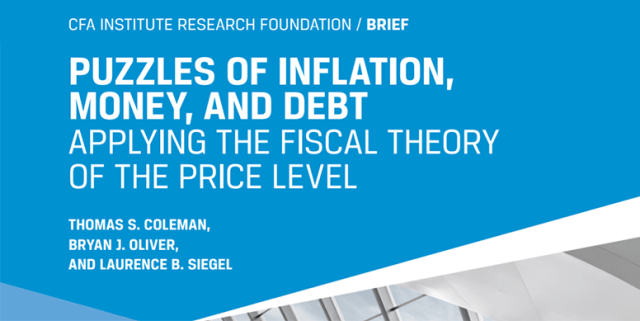“We all know the importance of fundamentals and fundamental value,” Brian Singer, CFA, said at the Alpha Summit GLOBAL by CFA Institute this past May. “[But] what do we do in an environment where fundamentals begin to take a backseat to public policy? What do we do when the phrase ‘market prices’ becomes an oxymoron?”
As moderator of the “Navigating Today’s Investment Conundrums” session, Singer, who is founder and co-CIO of ViviFi Ventures, explored these questions with panelists Jason Hsu, chair and CIO at Rayliant Global Advisors; Albert Trank, CFA, executive managing director and portfolio manager at PGIM Private Capital; and Anne Walsh, CFA, managing partner and CIO for fixed income at Guggenheim Investments.
Their consensus: Unconventional monetary policy has exerted an “absolutely crazy” influence on markets, and to avoid being overwhelmed by this new reality or any subsequent structural shifts, investors should keep three key themes in mind.
The Structural Shifts: “Absolutely Crazy” and “Unprecedented”
Today’s ongoing market turmoil can be understood as a series of aftershocks that followed a major tectonic shift in monetary policy, according to the panelists. The US Federal Reserve’s balance sheet has gone from 5% to 30% of US GDP, Singer noted, while the Bank of Japan (BOJ)’s went from 20% to more than 130%. A central bank’s traditional role is to maintain stable currency values by controlling reserves. But the Fed’s reserve holdings as a percentage of its balance sheet went from a few percentage points to 40%. “That’s absolutely crazy to try to understand how that may influence markets,” Singer said.
Just how profound have the Fed policy changes been? Walsh provided a chart showing the M2 money supply and M2 velocity from 1960 through early 2022. “Since the global financial crisis, the Fed has been on a mission, it seems, to be very much deeply involved in the markets,” she said. In the post-COVID-19 period alone, the M2 money supply increased 26%.
“That is an unprecedented rate of money supply hitting into the system,” Walsh continued. “Now, [the Fed] had to have felt that there was going to be an impact. They had to have seen that. But apparently, it took them by surprise.”
“Velocity of money,” or the rate of turnover in the supply, implies that pouring money into the system will create a stimulus effect: The more money in the system, the more it will move around. But since the mid-1990s, this dynamic hasn’t played out.
“We are seeing a huge decline in money supply, and this liquidity is being pulled out of the system very rapidly,” Walsh said. “We’ve gone from the Fed buying $120 billion a month of financial instruments, debt instruments, to zero, and now they are going to allow the balance sheet to roll off by approximately $100 billion a month. That’s a $220-billion-a month swing. It will have an effect that combined with rates will definitely have a demand-destruction impact.”
And that means that far from being on the sidelines of the financial markets, the Fed has a much more determinative influence.
“To the point of manipulation, they are absolutely involved in our markets,” Walsh said. “With a balance sheet of nearly $9 trillion, they pretty much are the market.”
So, why has the velocity of money continued to drag? Walsh believes it’s because the liquidity injected into the system has not been put to economically productive use. Instead, it went into investments and inflated asset prices across the board.
“While the Fed was trying to have an impact on the economy, what they really did was have an impact on markets,” she said. “So, this demand for money was not driven by traditional or historical business demand but was in fact driven by investor demand.”

Of course, just because the Fed has its foot on the accelerator doesn’t mean it’s steering the car.
“It’s a huge, huge influence that exists across markets, but policy is not necessarily in control,” Singer said.
And that has affected investment behavior. “There’s been a tremendous incentive to take risk and buy assets and invest, and we certainly see that in terms of asset valuations,” Trank said. “The very low interest rate environment has clearly had an impact on institutional investors like insurance companies and pension funds that have many old liabilities at fixed costs.”
But the reaction to all this unorthodox monetary policy has not been uniform for all markets. “Japan has printed even more money, but it hasn’t created the same kind of outcome that we’ve seen in the US,” Hsu said. “So, there’s something that’s quite culturally different in the US that if you get the zero rate, you got easy money, people will go and do something with it. . . . In Asia, whenever they print money, all you ever see is bank deposits increase and you see real estate prices increase.”
So, what happens when a decade and a half of monetary stimulus finally starts to wind down? Walsh expects complications. Historically, the Fed begins its tightening cycle when the economic outlook is more bullish than it is today.
“That the Fed is moving so rapidly to pull liquidity out, however, is likely to portend a policy mistake,” she said. “As long as the economy continues to slow or they see headline inflation drop, they’re going to continue on this trajectory of quantitative tightening, but they are going to be informed by market behavior.”
And despite sharply declining asset prices, the markets have held up pretty well. The retreat has been an orderly one so far, so the Fed hasn’t had to adjust its tightening policy. But that could change.
“Eventually, there is likely to be a market event which the Fed will perceive to be systemic in its risk,” Walsh said. “They may be forced to pivot sooner rather than later because they are moving so rapidly in this tightening direction.”
And that makes a focus on fundamental value, among other insights, all the more important for investors today.

1. A Long-Term Fundamental Focus Beats Wealth Destruction (Eventually)
A return to a long-horizon, fundamentals-based outlook could yield critical insights for investors in the current environment and help reduce behavioral biases and reactive thinking. Indeed, Trank believes a focus on fundamental value and a long-term perspective are important in any environment precisely because investors always face difficult circumstances, unexpected events, and the potential for worst-case scenarios. “We can have this session at any time, over history, and we’re going to come up with the five things that keep us up at night,” he said. “And it seems that we always get through it. But as a long-term investor, you want to partner with companies that are going to create value, that have good management skills, that are going to navigate the markets.”
Moreover, the changes roiling markets today could herald a return to rationality. “We look at this dislocation potential for recession favorably because wider spreads and better terms are a likely outcome as well,” Trank said. “You’d expect to see a shakeout in in the asset management industry [because] a lot of people have been drawn into these asset classes.”
Hsu homed in on Trank’s last point. He believes tighter monetary policy will make markets more rational and value oriented. As cheap money dries up, so will speculative behavior. “We’re going to see this shift in the market psychology,” he said. “That’s going to have a primary impact in destruction of wealth.”
The way Hsu sees it, much of the wealth creation in the last bull market was illusory to start with. “That was not value-driven, cash flow-driven wealth,” he said. “So, that revaluation of assets, I think, is going to have a first-order primary effect and everything will cascade from there.”

2. Fixed Income and Private Assets Deserve a Fresh Look
Some of the benefits of this revaluation process are already taking shape, especially around fixed income. “The one good thing about being a fixed-income investor right now is income,” Walsh said. “We haven’t actually seen income for a while. In 2021, spreads were compressed and yields were low. And it’s quite a different market now.”
That could open new opportunities in long-ignored securities.
“There are asset classes that we haven’t participated in,” she said. “With mortgage loans, the residential level coming in at 5%, now suddenly mortgage-backed securities may have some appeal too, and you don’t have to necessarily go down in credit quality to get these new income levels.”
Walsh also sees an upside for value-focused equity investors. “The entire market is repricing on a valuation basis, and P/Es are compressing back down to what we might have referred to as normal valuation levels,” she said. “There are values to be had for investors with a long-term focus. And by ‘long term,’ I do not mean quarter to quarter.”
Trank thinks bonds may be worth a fresh look as well. “I’d expect to see a lot more of that activity with the increasing rates,” he said. “With respect to terms and covenants, they become more valuable when there is volatility, when there is economic stress.”
He also sees potential advantages in private assets in the current period. “They can look exclusively at long-term value creation,” he said. “They don’t have to worry about quarterly earnings, and you get a lot of suboptimal behavior when you’re really focused on managing to the quarterly earnings report.”

3. “Forget the Old Lessons”: Be Contrarian
Now might also be the time to consider looking across the world for new opportunities. “You might truly want to be globally diversified,” Hsu said. “What are the markets and regions where you could expect different dynamics? Are there markets that have a positive rate of interest? Are there markets where inflation is not the primary concern, where there’s room for policy that is the opposite of what global central banks are going to do?”
He recommends we reject the conventional wisdom of the last bull market and move away from the concentration in US tech companies.
“Forget the old lessons,” he said. “What are the companies that really can produce value when rates are normalized? What are the economies other than the US that potentially might be the next regions where they might be easing and where there might be a revaluation of assets upward rather than downward?”
Hsu believes we should put on our contrarian hats. “You want to go where the fear premium is high but where most of the risk may have played out already,” he said. “The US isn’t quite there yet. I don’t think there’s enough fear just yet. . . . I think there’s still a lot of optimism and so a lot of froth to play out.”
For those willing to be “the total contrarian,” Hsu recommends looking at emerging markets. “EM’s are really battered down,” he said. “EM has traditionally been such a strong commodities play, and commodities are about the only asset class that’s done well.”
Much of the decline in emerging markets has been driven by spillover effects from currency weakness, according to Hsu. “A lot of that risk may have played its course,” he said, “and now it’s just a lot of fear premium waiting for someone who’s got the stomach to go collect.”
If you liked this post, don’t forget to subscribe to the Enterprising Investor.
All posts are the opinion of the author. As such, they should not be construed as investment advice, nor do the opinions expressed necessarily reflect the views of CFA Institute or the author’s employer.
Image credit: ©Getty Images/g-stockstudio
Professional Learning for CFA Institute Members
CFA Institute members are empowered to self-determine and self-report professional learning (PL) credits earned, including content on Enterprising Investor. Members can record credits easily using their online PL tracker.

